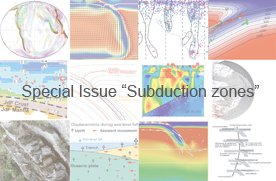Insight into collision zone dynamics from topography: numerical modelling results and observations
Abstract. Dynamic models of subduction and continental collision are used to predict dynamic topography changes on the overriding plate. The modelling results show a distinct evolution of topography on the overriding plate, during subduction, continental collision and slab break-off. A prominent topographic feature is a temporary (few Myrs) basin on the overriding plate after initial collision. This "collisional mantle dynamic basin" (CMDB) is caused by slab steepening drawing, material away from the base of the overriding plate. Also, during this initial collision phase, surface uplift is predicted on the overriding plate between the suture zone and the CMDB, due to the subduction of buoyant continental material and its isostatic compensation. After slab detachment, redistribution of stresses and underplating of the overriding plate cause the uplift to spread further into the overriding plate. This topographic evolution fits the stratigraphy found on the overriding plate of the Arabia-Eurasia collision zone in Iran and south east Turkey. The sedimentary record from the overriding plate contains Upper Oligocene-Lower Miocene marine carbonates deposited between terrestrial clastic sedimentary rocks, in units such as the Qom Formation and its lateral equivalents. This stratigraphy shows that during the Late Oligocene–Early Miocene the surface of the overriding plate sank below sea level before rising back above sea level, without major compressional deformation recorded in the same area. Our modelled topography changes fit well with this observed uplift and subsidence.






